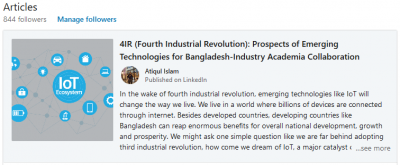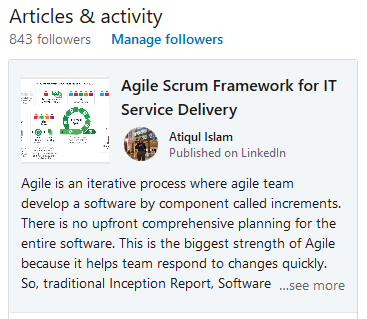タイトル
メッセージの内容
タイトル
メッセージの内容
Confirm
メッセージの内容
Loading..
Crowdsourcing Workshift > Search Freelance > atique7s > Portfolio
atique7s
Send Message
-
schedule Status:Available to work
- Appraisal :
- Job History(F) : 0 Results
- Identified
- Bangladesh
- Favorites : 0 Results
- Skills
- Technical Writing
- Website Content
- Creative writing
- Article and Text Writing
- Writing with Considering SEO
- Last Login : 2019-03-25
- Member Since : 2019-02-17
-
4IR: Prospects of Emerging Technologies for Bangladesh-Industry Academia CollaborationTranslation, Writing, and Naming Writing Technical WritingDuration to complete job3daysIn the wake of fourth industrial revolution, emerging technologies like IoT will change the way we live. We live in a world where billions of devices are connected through internet. Besides developed countries, developing countries like Bangladesh can reap enormous benefits for overall national development, growth and prosperity.

We might ask one simple question like we are far behind adopting third industrial revolution, how come we dream of IoT, a major catalyst of fourth industrial revolution. Bangladesh is experiencing demographic dividend of its millions of underutilized resource pool of young talents. This young segment of the population is very agile in their way of learning new technologies. This densely populated country is now a hub of millions of smart things of internet known as “Smartphones”. Other things of internet like sensors are becoming cheaper. The country has recently connected to 4G. 5 telecom operators have a good coverage of internet throughout the country. Government is taking internet to the last mile of rural areas through fiber optic cables.
Yet with all these prospects, Bangladesh is facing grave challenges in its effort to traffic management. City life is badly hampered. Productivity and work efficiency are also affected due to hours lost in traffic jam. Traditional traffic lights with predefined interval of ON and OFF is of no use. IoT can solve this problem. Low cost vehicle detecting sensors placed at road sides at certain intervals (500 to 1000 meters) can collect real time data of vehicles, send to microcontroller (Raspberry Pi) and then to cloud for processing. The processed data then communicates to traffic light to automatically turn ON or OFF. Automatic number plate recognition (ANR) system will automatically detect reported stolen vehicles, unlicensed or illegal ones and prompt for action.
Country’s energy sector can also reap benefits of IoT. Smart metering can unleash immense potential for safe energy consumption. IoT will soon revolutionize agriculture and health sector. IoT can increase, protect and optimize crop production. For starters in Bangladesh, farmers can not access local weather station. IoT can be used to create mini weather station with affordable cost for soil moisture, heat, temperature, wind and water flow sensors. Wearable devices will monitor both domestic animals and human to reveal valuable health insight through analysis of real time data. Smartwatch and other wearables will report slightest changes in human body to facilitate precautionary measures.
To harness the true potential of IoT in context of Bangladesh, collaboration between industry and academia is a must to promote research and development. Developed countries have started using IoT in agriculture and other sectors. Use cases of IoT in developed countries may not be applicable in context of Bangladesh. To a given problem like Dhaka City traffic management, there can be multiple solution like video data analysis/image processing, GPS, IR Sensor, Ultrasonic Sensor, RFID, Chip based technology attached with vehicle and many more. Only research can sort out the best option to adopt a holistic approach to vehicle and traffic management, toll administration, parking management. Due to the lack of collaboration between industry and academia, graduates remain in the complete darkness regarding what’s happening in the industry and professors also fail to equip them as per industry requirement. Industry too suffers from lack of research and innovation because universities are hub for research works.
Food security, environment pollution, increased crime are now rising concerns we can address with the application of emerging technologies. Emerging technologies like Internet of Things (IoT), Data Science, Artificial Intelligence (AI), Machine Learning, Block Chain, Natural Language Processing (NLP) have great role to play to reshape the future.
eGeneration Ltd., one of the fastest growing technology consulting firms in Bangladesh is working towards this ambition. To bridge industry academia gap to promote research and development on emerging technologies, eGeneration is already working with professors and research team of renowned universities like University of Dhaka, United International University. A team of software engineering professionals under mentoring of industry experts, researcher and university professor are devoted to R & D of NLP, Data Science and other cutting-edge technologies. The team is currently implementing AI and Blockchain based solution for Smart Crowd, a Dubai based crowd funding company. There are numerous examples where industry and academia collaboration resulted in innovation, entrepreneurship and revolution in health, agriculture and other sectors. -
Agile Scrum Framework for IT Service DeliveryTranslation, Writing, and Naming Writing Technical WritingDuration to complete job3daysAgile is an iterative process where agile team develop a software by component called increments. There is no upfront comprehensive planning for the entire software. This is the biggest strength of Agile because it helps team respond to changes quickly. So, traditional Inception Report, Software Requirement Specification (SRS), Software Design Document (SDD), Source Code Document etc. heavy documentation are discouraged and not feasible in Agile. However, Software Architecture design is feasible upfront. Of course, Agile Scrum does planning but that planning is not the comprehensive one for the entire software to be developed. Considering iterative incremental development, Agile Scrum development lifecycle is divided into several Sprints. At the end of each Sprint, there is a functioning Product Increment as deliverable. Product Increment is not a complete product but when all Sprints are done, product increments together make a complete software.

1. SCRUM WORKFLOW
Scrum process runs in short cycles of sprints. Every Sprint is for a duration of 2-4 weeks. A Sprint lifecycle consists of 4 events:
1.1 Sprint Planning: Sprint is a fixed duration of time when Scrum Team delivers a product increment. A Sprint can be as small as 2 weeks to as max as 4 weeks. It emphasizes to get feedback early and frequently so that Scrum Team can respond to changes frequently.
Sprint Planning meeting is a time boxed meeting. For a 2 weeks Sprint, ideal duration for Sprint Planning meeting is 8 hours.
During the Sprint Planning meeting, all chunks of work are selected and defined by the Team and the Product Owner. Tasks are assigned to individuals.
1.2 Daily Scrum/Stand up: Daily Scrum is a time boxed meeting of 15 minutes. On a daily basis, the Team discusses their progress and impediments in a 15-minute stand-up meeting.
1.3 Review: It’s a maximum 4-hour time bound meeting for a 4 weeks Sprint. It is held at the end of the Sprint to review the output of the Sprint. Stakeholders and team members evaluate the deliverables or product increment of the Sprint. Review meeting at the end of a Sprint allows development team solicit feedback from stakeholders. Thus, they become clear about how they are performing in the eyes of the stakeholders. The end result is a revised backlog.
1.4 The Retrospective: It’s a 3 hours’ time bound meeting. It’s an opportunity for development team members to inspect what they have done and plan improvement if any. Next, the Team evaluates its performance. It makes improvements for the next sprint. Team identifies what went well and what went wrong. Then the Team is ready for the next Sprint Planning.
2. SCRUM ROLES
Scrum works with three roles:
2.1 Development Team: Team of developers responsible and committed to meet the sprint goal. The Scrum Team is a self-organizing multidisciplinary Team. It has different skillsets like coding, architecture design, database design, testing and is identified as one team. The team size is ideally 7+-2 excluding SM (Scrum Master) and PO (Product Owner). Scrum team members are empowered to take on the work and take them to their completion.
2.2 Product Owner: The Product Owner maintains the Product Backlog. He represents the committee of stakeholders. He prioritizes chunks of work and manages stakeholders.
2.3 Scrum Master: The Scrum Master coaches the Product Owner and the Team for Scrum practices. He is a communicator between stakeholder/Product Owner and team members. Scrum Master facilitates Sprint Planning Meeting between Product Owner and Development Team members.
He facilitates the Scrum process, increases agility and brings and keeps the Team up to speed.
3 SCRUM ARTIFACTS
Scrum is known for the use of post-its. We use posters and sticky notes to visualize the ambitions and work of a Scrum Team. These are the 4 lists of Scrum:
3.1 Product Backlog: Product Backlog is an ordered list of product features. These features are written in the form of user stories. Product Backlog is prepared and maintained by the Product Owner. Product Backlog is created by the Product Owner in coordination with the stakeholders and Development Team members. Product Owner may write these user stories with the help of the development team members and also from the stakeholders. User stories generate from what requirements are provided by corresponding stakeholders.
Development team works with Product Owner in the Product Backlog in the Sprint Planning Meeting to write it in a way that it is transparent to everyone. Product Backlog includes feature idea, enhancement, bug fix and documentation. It can be as minor as a feature request or as big as a design change. Product backlog is never complete, it is dynamic. Requirements/features are taken from Product Backlog to Sprint Backlog to distribute among development team members.
This list is made at the project kick-off and is updated every sprint.
3.2 Sprint Backlog: A Sprint Backlog is a list of product features or works in the current Sprint taken from the Product Backlog. Not all the product features/requirements/works are taken from the Product Backlog.
Sprint Backlog acts like a Scrum Board having columns like To Do, On Progress and Done. All the tasks go into the To Do column, and during the sprint these move from On Progress to Done. When all tasks are Done at the predetermined Sprint deadline, it’s time for the Review. The team then goes to the next Sprint.
3.3 Increment: The Increment is the sum of all the Product Backlog items completed during a Sprint. At the end of a Sprint, the new Increment must be a working product.
The Scrum Team needs to have consensus on what is considered to be an Increment. This varies significantly per Scrum Team, but, team members must have a shared understanding of what it means for work to be complete.
The same understanding guides the Team in knowing how many Product Backlog items it can select during a Sprint Planning.
3.4 Burn-Down Chart: Burn-Down Chart helps team assess the total work remaining in the Sprint Backlog. By tracking the remaining work throughout the Sprint, the Team can manage its progress.
This has been proven to be a useful technique in monitoring the Sprint progress towards the Sprint Goal.
The Product Owner tracks this total work remaining at least every Sprint Review. The Product Owner compares this amount with work remaining at previous Sprint Reviews to assess progress toward completing the projected work by the desired time for the goal. This information is shared with all stakeholders.









